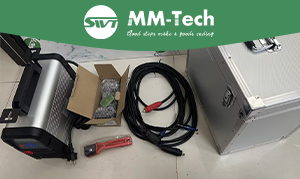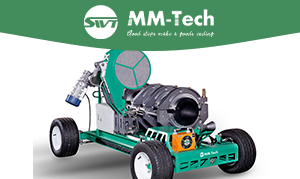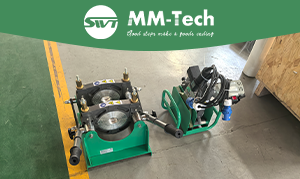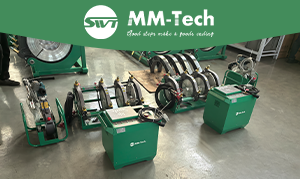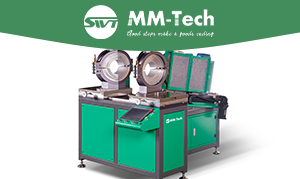You need special welding equipment to join HDPE pipes for oil pipelines. This equipment helps make strong joints that do not leak. These joints keep oil moving safely through the pipes. Good machines give you results you can trust and follow strict rules. When you use certified tools, you keep the pipeline and the environment safe.
Key Takeaways
Pick the right welding method for the pipe size and project. This helps make strong joints that do not leak. Strong joints keep oil pipelines safe. – Use certified welding machines like MM-Tech for good control. These machines have safety features and track data. This helps make sure welds are high quality. – Get pipe ends ready and line them up before welding. Use tools like clamps and facing devices to help. This stops weak joints and leaks from happening. – Follow strict rules and train workers well. This helps meet safety laws and makes joints that last a long time. – Keep welding equipment safe from bad weather. Take care of it so it works well everywhere.
HDPE Pipe Welding Overview
Importance in Oil Pipelines
Pipelines need strong joints so oil does not leak. HDPE pipe welding makes these joints strong. Using the right welding method helps stop leaks and spills. This keeps the environment safe. It also helps the pipeline handle high pressure and shaking.
Here are the main welding methods for HDPE pipes in oil pipelines:
Butt fusion: Heats pipe ends and presses them together. This makes a joint as strong as the pipe.
Electrofusion: Uses fittings with heating wires inside. You put pipe ends in the fitting and use electricity. This works well for small pipes or pipes of different sizes.
Socket fusion: Heats the pipe outside and fitting inside. You push them together for a tight seal. This is best for pipes up to 2 inches wide.
Saddle fusion: Lets you add a branch by fusing a saddle-shaped fitting to the pipe.
Tip: Pick your welding method based on pipe size, project needs, and joint type.
HDPE welding helps you work faster and safer. Machines and certified fittings help stop mistakes. Trained workers can make joints that last a long time.
Aspect | Impact on Efficiency and Safety |
|---|---|
Strong, even joints stop leaks and do not fail under pressure or shaking. | |
Reduced Human Error | Machines and certified fittings help avoid mistakes. |
Compliance with Standards | Certified fittings follow ISO and EN rules, lowering legal risks. |
Mechanical Integrity | Welded joints are as strong as the pipe and handle pressure changes. |
Durability and Service Life | HDPE welds make pipelines last longer and need fewer repairs. |
Technical Standards
You must follow strict rules when welding HDPE pipes for oil pipelines. These rules help you make safe, strong joints that meet industry standards.
ISO and EN standards: These rules cover pipe quality, welding, and testing. Using certified fittings and following these rules keeps your project safe and legal.
Welding parameters: You must control heat, pressure, and time during welding. If you set these right, you get strong joints. If not, you may get weak spots or leaks.
Operator training: Only trained and certified people should weld HDPE pipes. Good training helps stop mistakes and keeps everyone safe.
Traceability: Many projects use barcodes or RFID tags to track each weld. This helps you check weld quality and keep good records for safety checks.
Note: Always check the newest rules before you start. Using best practices and the right tools helps you build a safe, long-lasting oil pipeline.
Main Welding Equipment Types
When you build oil pipelines with HDPE pipes, you need special welding equipment. Each machine does a different job. Some machines are best for big pipes. Others are good for small pipes or tight places. Here are the main types you will use.
Tip: The right welding equipment helps you make strong joints. These joints do not leak and last a long time.
Butt Fusion Machines (MM-Tech)
Butt fusion welding is used most for joining big HDPE pipes in oil pipelines. You use a butt fusion machine to heat two pipe ends. Then you press them together. This makes a joint as strong as the pipe.
Here is a table with the main features of MM-Tech butt fusion machines:
Feature | Description |
|---|---|
Welding Range | 90mm to 1200mm (covers small to very large pipes) |
Applicable Materials | PE, PP, PVDF |
Power Supply | 230V/400V, 50/60Hz |
Control System | |
Safety Features | Remote control for heating plate and trimmer, stable trimmer, storage support |
Data Handling | Stores up to 2000 welding reports, USB download |
Certifications | CE certified, meets DVS, ISO, and WIS standards |
Accessories | Teflon-coated heating plate, electrical milling cutter, quick couplings |
Warranty | 24 months with free replacement of defective parts |
MM-Tech butt fusion machines are simple to use. The control box has a touch screen and RFID for safety. The Teflon-coated heating plate keeps welds clean. The machine saves welding data for your records. You can use these machines for PE, PP, and PVDF pipes.
MM-Tech machines work well in hard jobs. They handle high pressure and big pipes. The machines have strong hydraulics and safety features to keep you safe. You also get a 2-year warranty for peace of mind.
Note: MM-Tech butt fusion machines meet world standards and have happy customers. You can trust them for all sizes of projects.
Electrofusion Welding Machines (MM-Tech)
Electrofusion welding is another way to join HDPE pipes. It is good for small or medium pipes or tight spaces. You use an electrofusion machine to send electricity through a fitting with wires. This melts the pipe ends and fitting to make a strong joint.
MM-Tech electrofusion machines have many smart features:
They go beyond world rules for voltage, time, and temperature.
The MCU control unit helps you set and check welding settings.
They react fast to power changes to keep welds steady.
You can use them on many job sites because of the wide voltage range.
The LCD screen is bright and shows Chinese and English.
You can see voltage, current, heat, and time as you weld.
They have an IP54 rating, so they work in tough places.
You get a 24-month quality guarantee.
You can use MM-Tech electrofusion machines for gas, water, and oil pipelines. They make strong, leak-proof joints. The machines save welding data and let you use a USB drive to export it. This helps you keep track of your work and show weld quality.
Tip: Electrofusion welding is great for fixing pipes, adding branches, or working where big machines cannot fit.
Socket Fusion Tools
Socket fusion tools help you join small HDPE pipes. You heat the pipe outside and the fitting inside. Then you push them together. This way is easy and does not cost much. You use socket fusion in gas, water, and factory pipes. It works well in small spaces or when you need to make many joints by hand.
Easy to carry and use.
Good for pipes up to 2 inches wide.
Makes joints that do not leak.
Great for small fixes or branch lines in oil pipelines.
Extrusion Welders
Extrusion welders are special tools for thick HDPE materials. You use them to make strong, sealed joints. They are good for welding sheets or fixing damaged pipes.
Benefits of extrusion welders:
They make strong welds, almost as strong as the pipe.
They seal well and stop leaks.
You do not need extra filler.
They resist rust and save energy.
You can change welding settings for better control.
You need more skill to use extrusion welders. The tools can cost more. But they are good for thick pipes and special fixes in oil pipelines.
Here is a table that sums up the main welding equipment for HDPE pipes in oil pipelines:
Welding Method | Equipment Components | Working Principle Summary | Application in Oil Transportation Pipelines |
|---|---|---|---|
Butt Fusion Welding | Welding machine (heating plate, pressure plate, control system) | Heats pipe ends and presses them together for a strong joint | Best for big pipes and main oil or gas pipelines |
Electrofusion Welding | Electrofusion ring (with heating wire), power supply | Uses electric current to heat a ring that melts pipe ends and fittings | Good for small or medium pipes, repairs, and tight spaces |
Socket Fusion Welding | Heating tools (plates, sleeves) | Heats pipe and fitting, then joins them for a tight seal | Used for small pipes, branch lines, and hand work |
Extrusion Welding | Extrusion welder, heating element | Melts and pushes out plastic to make a strong, sealed joint | Used for thick pipes, sheet welding, and special repairs |
Remember: The right welding equipment helps you build safe, long-lasting oil pipelines. MM-Tech gives you good solutions for every welding job.
Welding Equipment Features
Operation and Control
Modern welding equipment for HDPE pipes is easy to use. You can set the heat and pressure with digital controls. This helps you make strong joints every time. Machines from MM-Tech use automatic systems to guide you. You follow steps on a bright screen. The screen shows you what to do next.
Many machines save data about each weld. They record the temperature, pressure, and time. You can store thousands of records. You can move the data with a USB drive. This lets you check your work and show you followed the rules. Some machines have a dual-axis frame. This keeps the force even on both sides. It helps make sure the joint is strong and does not leak.
Tip: Automatic controls and data saving help you avoid mistakes. They make sure every weld is done right.
Here is a table with some helpful features:
Feature | What It Does |
|---|---|
Digital Controls | Lets you set and watch welding steps easily |
Data Logging | Saves and moves weld records for checking quality |
Hydraulic Trimmer | Gets pipes ready for smooth, correct joints |
On-Board Heating Plate | Keeps heat steady and keeps the operator safe |
Safety and Compliance
You need to use safe welding equipment that follows strict rules. MM-Tech machines have safety parts like Teflon-coated heating plates and micro-switches. These parts help stop burns and accidents. The machines work well in hard places. You can use them at many job sites.
Welding equipment for oil pipelines must meet world standards. Look for machines with CE, ISO, and ASTM certifications. These show the equipment is safe and works well. Certified machines help you follow the law and keep your pipeline strong.
CE, ISO, ASTM, and API certifications show the equipment meets world safety and quality rules.
Machines with these certifications make joints as strong as the pipe.
Using certified equipment helps you avoid trouble and keeps your project going.
Note: Always check your welding equipment has the right certifications before you start work.
Equipment Selection Criteria
Pipe Size and Project Scale
You need to pick welding equipment that fits your pipe size. The size of the project also matters. Big pipes need special welding methods like butt fusion or electrofusion. These ways need careful control of heat and cooling. You must also line up the pipes just right. For big pipes, you use machines with strong hydraulics. Sometimes you need cranes to move the pipes. The pipe’s width and wall thickness help you choose the right machine. Small jobs can use light, manual machines. These are easy to carry and set up. Medium jobs work well with machines that are part automatic. Big jobs need machines that do most of the work by themselves. These machines help you finish faster and do more work.
For big pipes, use strong, certified machines with good controls.
For small pipes, pick simple, portable machines for fast jobs.
Match the machine’s features to how big your project is.
Tip: Always check the pipe size and what your project needs before you choose welding equipment.
Environmental Factors
The place where you work can change how your welding machines work. It is important to control the temperature. HDPE pipes do not move heat well. You must keep the right heat when welding. Hot weather can make machines too warm. Cold weather can make oil in the machine thick and slow. Wet air can make metal parts rusty. Dust can cover machine parts and make them work less well. Use covers to protect your machines. Clean them often to keep them working. Pick machines that can handle changes in weather and keep the right temperature.
In hot weather, watch for machines getting too hot.
In cold weather, use the right oil for low temperatures.
In wet places, keep machines dry and use things to stop rust.
In dusty places, clean machines and use covers to protect them.
Quality Assurance
You need to test your welds to make sure they are safe. Quality checks help stop leaks and breaks in the pipeline. You should do different tests:
The Tensile Strength Test checks if the pipe can be pulled without breaking.
The Hydrostatic Pressure Test uses high pressure to find leaks.
The Joint Integrity Test checks if the welds are strong.
The Installation and Handling Tests show if the pipe works well during setup.
These tests help you find problems early. You can fix them before using the pipeline. Always write down your test results. This helps with safety checks and later reviews.
Note: Good quality checks keep your project and the environment safe.
Best Practices
Preparation and Alignment
Getting ready before welding HDPE pipes is very important. You want every joint to be strong and leak-free. Follow these steps to prepare and align your pipes:
Clean the pipe ends with a lint-free cloth or an approved cleaning solution. Remove all dirt, grease, and moisture.
Inspect the pipe ends for cracks or uneven surfaces. Fix any problems before moving forward.
Use a facing tool to make the pipe ends smooth and parallel. This helps the pipes fuse together better.
Secure the pipes with alignment clamps or jigs. Make sure the pipes line up both horizontally and vertically.
Check the alignment by eye. Make small adjustments to avoid gaps or misalignment before you start welding.
Always take your time during preparation. Rushing can lead to weak joints and leaks later.
For electrofusion, you need less surface preparation. Clean the pipe ends, place the fitting, and align the pipes. This method saves time and reduces labor.
Ensuring Weld Quality
You want every weld to last for years. Use these techniques to make sure your welds are strong:
Keep the welding temperature steady. For butt fusion, aim for 400°F to 450°F.
Make sure pipe ends are clean and lined up before you start.
Apply the right pressure during welding and keep it steady while the joint cools.
For electrofusion, set the voltage between 40V and 45V. Allow enough cooling time before moving the pipe.
For socket fusion, heat both the pipe and fitting for the right amount of time. Align them carefully and let them cool fully.
Common weld failures happen because of misalignment, dirty pipe ends, or equipment problems. You can prevent these by:
Using alignment clamps and checking alignment often.
Keeping your welding equipment in good shape with regular maintenance.
Training your team on proper welding steps.
Checking every weld with visual inspection or ultrasonic testing.
Tip: Good preparation and careful welding help you build safe, long-lasting pipelines.
Picking the right welding equipment for HDPE oil pipelines is important. It helps you make pipes that are strong, safe, and last a long time. Certified machines, such as MM-Tech, let you weld with better accuracy. They make strong joints and keep good records of your work. These things help your pipelines work well, even in hard places.
Getting help from an expert helps you choose the best equipment for your job. It also helps you avoid mistakes and make better welds. Always ask a specialist for advice to get the best pipeline results.
FAQ
What is the best welding method for large HDPE oil pipelines?
You should use butt fusion welding for large HDPE oil pipelines. This method creates strong, leak-proof joints. MM-Tech butt fusion machines work well for pipes up to 1200mm. You get reliable results and easy operation.
How do you keep welding joints strong and safe?
You must clean and align pipe ends before welding. Use certified machines like MM-Tech for steady heat and pressure. Always check welds after you finish. Good preparation and the right equipment help you avoid leaks.
Can you use MM-Tech welding machines in harsh environments?
Yes, you can use MM-Tech machines in tough places. They have strong parts and an IP54 rating. This means dust and water will not stop them from working. You can trust them on outdoor job sites.
What certifications do MM-Tech welding machines have?
MM-Tech welding machines meet CE and ISO standards. These certifications show the machines are safe and reliable. You can use them for oil, gas, and water pipelines with confidence.


